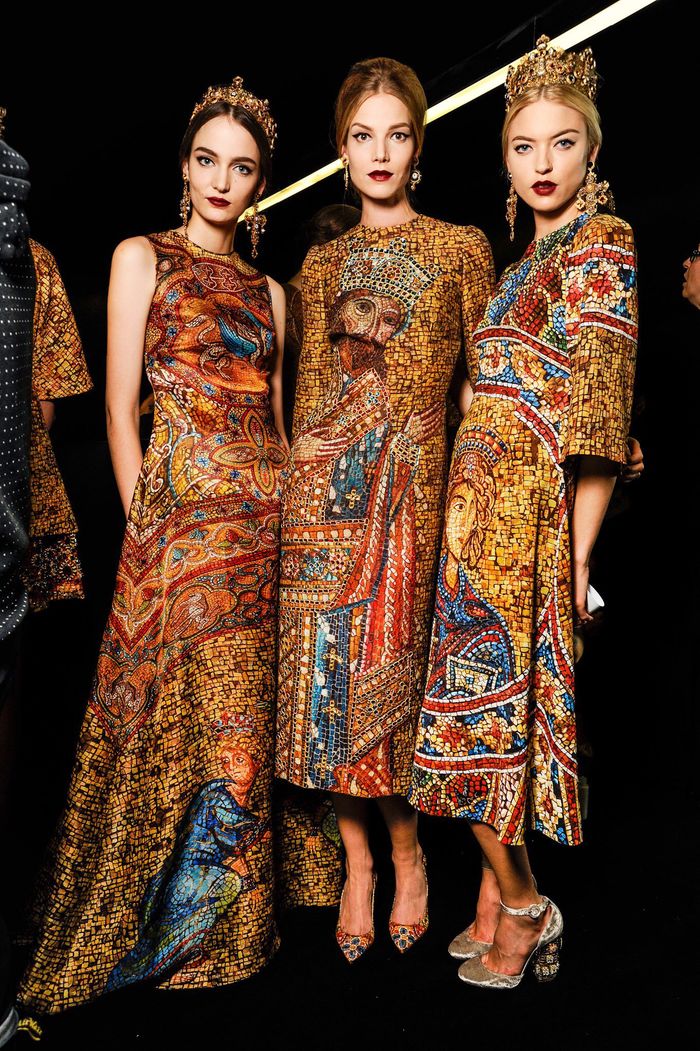The religious symbol
In the next instalment of her ‘Love Jesus, but make it fashion’ series, columnist Eliane Bedu explores how the religious symbol is used in fashion
A symbol’s essence is to be inexhaustible. It conveys one or multiple meanings which can only be revealed depending on one’s level of understanding. That is how you could be seeing, or in the case of fashion, wearing symbols without even knowing it, as Miranda Priestly reminded Andy Sachs about Oscar de la Renta’s Cerulean blue in The Devil Wears Prada. Since the 1990s, the Catholic religious symbol has systematically been used in designers’ collections, from a straightforward Madonna on the front of a dress, to the more implicit recalls on bags and earrings.
“Some items [...] are meant to be looked at, appreciated as a painting would be”
Domenico Dolce and Stefano Gabbana are the masters of Christian representation in high fashion. In the last 20 years, the brand’s religious symbolism has multiplied itself, finding its way into numerous runways as in 2013, 2015, or 2019. The countless churches, the art, and the general ambiance have constituted the brand’s aesthetic. From red-carpet outfits to Ready-to-Wear items, Catholicism is omnipresent. Some pieces, such as one dress from the Fall 2018 Ready-to-Wear collection, are practically unwearable. Entirely made of sequins, a Virgin Mary is praying on the breastplate of the dress, surrounded by a golden halo and stars. Two angels are holding a crown above her head. This piece, for example, is pure art. As much as I am a supporter of overdressing, some items are just too much to go to your local Sainsbury’s — they are meant to be looked at, appreciated as a painting would be.

However, other pieces from the brand are little more effortless. Crosses, before becoming a high fashion symbol, were associated with a gothic Y2K style. D&G has re-used this popular image in its latest collections, as in Spring 2019, where the brand launched sweat-shirts and jersey dresses representing a praying Virgin Mary in a ‘street-art’ style. While bearing the inscription “tradizione”, these latest religious collections blow a modern wind, adapting the sacred to streetwear in a spirit of provocation. In another mindset, Gucci, with its non-binary geek-chic style, has used the symbol of ‘transverberation’, which can also be found in D&G and other designers’ collections. ‘Transverberation’ is defined as a mystical experience during which the devotee’s heart is being speared spiritually, and is represented by a heart pierced by one or several swords. Gucci most famously used the symbol in Lana del Rey’s outfit for the Met Gala 2018, but it was also seen on one of the models in Jean-Paul Gaultier’s Spring 2007 Couture collection, and in D&G’s ‘devotion’ line which includes bags, shoes and belts.
“Maybe God is now forging fashion as well”
It should be noted that not all brands are this splashy and extravagant. Versace, for example, has been using a sobering cross since Fall 1997 — Gianni’s last runway show before his tragic assassination. In this collection, nine outfits display byzantine inspired crosses, including the wedding dress worn by Naomi Campbell. Since then, Versace has reused the symbol several times, as in 2012 and 2018. Gold crosses inlaid with precious stones on dresses, however, are not a recent invention. 17th century rigorism found its way into royal fashion, where crosses were sewed onto the breastplates of basket dresses, exhibited in a portrait of Marie de Medici, Louis XIII’s mother, painted in 1610 by Frans Pourbus the Young.
However, most religious symbols in fashion are found in accessories. Dolce & Gabbana’s Fall 2013 Ready-to-wear collection was considered to be the biggest exhibition of religious accessories in the history of high fashion with its incense burner shaped bags, cross earrings, crowns, baroque shoes… Since then, religious jewellery has become a part of the brand’s identity. For next fall, D&G has released rosary-inspired earrings and necklaces in order for the customers to take ownership of the religious symbol little by little, before diving in with head-to-toe religious outfits. Models too are becoming living symbols. Jean-Paul Gaultier well understood this, when, in 2007, he plastered their faces as if they were Madonnas, white tones and blood teardrops, recalling the miracles of the weeping statutes as halos to complement the flowy chiffon and lace dresses.
Why do designers use the religious symbol in their work? Are couturiers trying to expose their membership of a certain community? Are they being provocative, driven by their criticism of the Church? Or maybe God, with His creative force, as the first designer after having inspired philosophers, architects, sculptors, writers, painters and musicians, is now forging fashion as well...
 Comment / Cambridge’s tourism risks commodifying students18 April 2025
Comment / Cambridge’s tourism risks commodifying students18 April 2025 News / Cambridge student numbers fall amid nationwide decline14 April 2025
News / Cambridge student numbers fall amid nationwide decline14 April 2025 News / Greenwich House occupiers miss deadline to respond to University legal action15 April 2025
News / Greenwich House occupiers miss deadline to respond to University legal action15 April 2025 Comment / The Cambridge workload prioritises quantity over quality 16 April 2025
Comment / The Cambridge workload prioritises quantity over quality 16 April 2025 Sport / Cambridge celebrate clean sweep at Boat Race 202514 April 2025
Sport / Cambridge celebrate clean sweep at Boat Race 202514 April 2025





